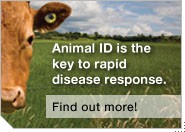Newsroom
Bovine Tuberculosis Signs and Symptoms |
|
Q. What are the symptoms of TB?
A. TB is difficult to diagnose with clinical signs alone. In the early stages of TB, clinical signs are not visible. In later stages, clinical signs may include: emaciation, lethargy, weakness, anorexia, low-grade fever, and pneumonia with a chronic, moist cough. Lymph node enlargement may also be present.
Q. What should I do if my animals show these symptoms?
A. If you suspect TB in your herd, you should isolate the animal immediately and then call your veterinarian for a proper diagnosis.
Q. How does TB get into cattle herds?
A. TB can be passed to a herd by infected cattle, cervids, swine, and humans. It is spread through the respiration of TB bacteria aerosols, through feed or watering sites contaminated with saliva and other discharges, or by drinking raw, unpasteurized milk from infected animals. The risk of exposure is greatest in enclosed areas, such as barns with poor ventilation.
Last Modified: September 10, 2008
